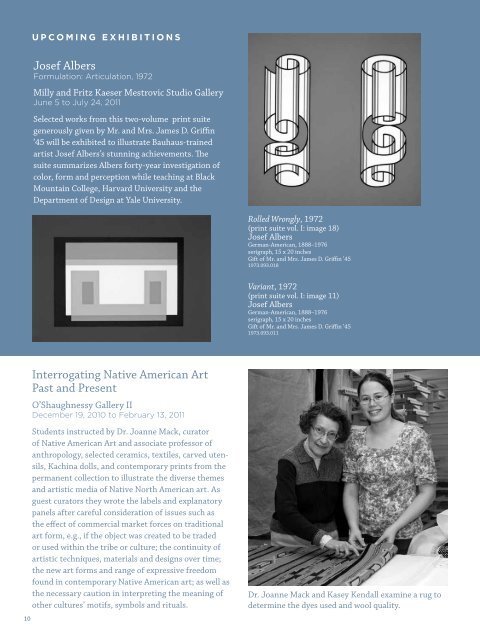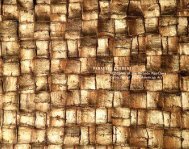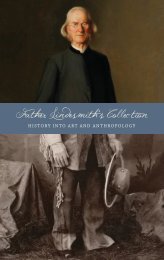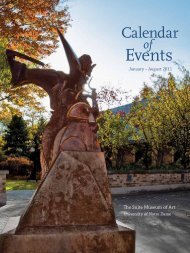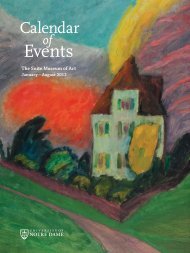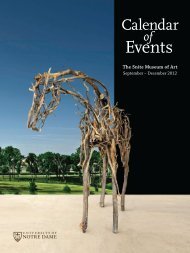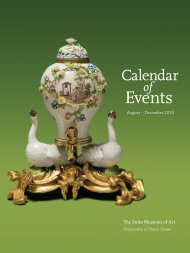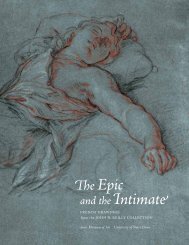The Snite Museum of Art - Snite Museum of Art - University of Notre ...
The Snite Museum of Art - Snite Museum of Art - University of Notre ...
The Snite Museum of Art - Snite Museum of Art - University of Notre ...
You also want an ePaper? Increase the reach of your titles
YUMPU automatically turns print PDFs into web optimized ePapers that Google loves.
10<br />
upcomIng ExhIbItIons<br />
Josef Albers<br />
Formulation: <strong>Art</strong>iculation, 1972<br />
Milly and Fritz Kaeser Mestrovic Studio Gallery<br />
June 5 to July 24, 2011<br />
Selected works from this two-volume print suite<br />
generously given by Mr. and Mrs. James D. Griffin<br />
’45 will be exhibited to illustrate Bauhaus-trained<br />
artist Josef Albers’s stunning achievements. <strong>The</strong><br />
suite summarizes Albers forty-year investigation <strong>of</strong><br />
color, form and perception while teaching at Black<br />
Mountain College, Harvard <strong>University</strong> and the<br />
Department <strong>of</strong> Design at Yale <strong>University</strong>.<br />
Interrogating Native American <strong>Art</strong><br />
Past and Present<br />
O’Shaughnessy Gallery II<br />
December 19, 2010 to February 13, 2011<br />
Students instructed by Dr. Joanne Mack, curator<br />
<strong>of</strong> Native American <strong>Art</strong> and associate pr<strong>of</strong>essor <strong>of</strong><br />
anthropology, selected ceramics, textiles, carved utensils,<br />
Kachina dolls, and contemporary prints from the<br />
permanent collection to illustrate the diverse themes<br />
and artistic media <strong>of</strong> Native North American art. As<br />
guest curators they wrote the labels and explanatory<br />
panels after careful consideration <strong>of</strong> issues such as<br />
the effect <strong>of</strong> commercial market forces on traditional<br />
art form, e.g., if the object was created to be traded<br />
or used within the tribe or culture; the continuity <strong>of</strong><br />
artistic techniques, materials and designs over time;<br />
the new art forms and range <strong>of</strong> expressive freedom<br />
found in contemporary Native American art; as well as<br />
the necessary caution in interpreting the meaning <strong>of</strong><br />
other cultures’ motifs, symbols and rituals.<br />
Rolled Wrongly, 1972<br />
(print suite vol. I: image 18)<br />
Josef Albers<br />
German-American, 1888–1976<br />
serigraph, 15 x 20 inches<br />
Gift <strong>of</strong> Mr. and Mrs. James D. Griffin ’45<br />
1973.093.018<br />
Variant, 1972<br />
(print suite vol. I: image 11)<br />
Josef Albers<br />
German-American, 1888–1976<br />
serigraph, 15 x 20 inches<br />
Gift <strong>of</strong> Mr. and Mrs. James D. Griffin ’45<br />
1973.093.011<br />
Dr. Joanne Mack and Kasey Kendall examine a rug to<br />
determine the dyes used and wool quality.<br />
rEcEnt acquIsItIons<br />
Gifts from the Emilio Sanchez Foundation<br />
<strong>The</strong> Emilio Sanchez Foundation generously gave the <strong>Snite</strong><br />
<strong>Museum</strong> over 100 paintings, drawings and prints by<br />
important Cuban-American artist Emilio Sanchez.<br />
Emilio Sanchez was born in Camagüey, Cuba in 1921. He<br />
began his artistic training at the <strong>Art</strong> Students League in<br />
1944 when he moved to New York City where he lived until<br />
he died in 1999. However, it was in Cuba that he became<br />
fascinated with the play <strong>of</strong> light and shadow on colored<br />
forms that became a dominant characteristic <strong>of</strong> his works.<br />
An artist with an independent voice and international<br />
acclaim, Sanchez has had over sixty solo exhibitions and<br />
has been included in numerous group shows in museums<br />
and galleries in the United States, Latin America and<br />
Europe. His art is well-represented in private and public<br />
collections including over thirty museums like the New<br />
York <strong>Museum</strong> <strong>of</strong> Modern <strong>Art</strong>, the Metropolitan <strong>Museum</strong><br />
and the Philadelphia <strong>Museum</strong> <strong>of</strong> <strong>Art</strong>. He has also received<br />
prestigious awards, such as first prize at the 1974 Biennial<br />
in San Juan, Puerto Rico.<br />
— Dr. Ann Koll, director, Emilio Sanchez Foundation<br />
This gift greatly advances the <strong>Snite</strong> <strong>Museum</strong>’s ambition<br />
to become a major resource for Latino art, from<br />
prehistoric to contemporary times. <strong>The</strong> <strong>Museum</strong><br />
has an outstanding collection <strong>of</strong> pre-Columbian art,<br />
which is being expanded to include colonial art and<br />
its later forms, such as religious imagery from New<br />
Mexico. In addition, the <strong>Museum</strong> is presently developing<br />
a collection <strong>of</strong> 19th-century and contemporary<br />
Latin American and Mexican photography, Mexican<br />
graphics <strong>of</strong> the 1930s and contemporary prints by<br />
Chicano artists.<br />
House with Yellow Fence, ca. 1980s<br />
Emilio Sanchez<br />
Cuban-American, 1921-1999<br />
oil on canvas, 48 x 48 inches<br />
Gift <strong>of</strong> the Emilio Sanchez Foundation<br />
2010.011.022<br />
11


